

The current economic downturn has ushered in an employment crisis of historic proportions. The U.S. unemployment rate jumped from its lowest level in over half a century to a high not seen since the Great Depression in a matter of only two months. Since mid-March, when the COVID-19 pandemic began taking an economic toll, Americans have filed a staggering 47.8 million initial jobless claims. And that does not include the millions more who are still employed but have had their hours reduced or wages cut.
All else being equal — the consequences of unemployment, while never desirable, vary in severity from state to state. Some parts of the country have relatively strong social safety nets, providing residents who are out of work access to a range of benefits with few restrictions. Additionally, the job market in some states has not been affected as severely as it has in others, suggesting that those who have been laid off have greater likelihood of returning to work soon.
Using data from the U.S. Department of Labor, 24/7 Wall St. created an index of measures related to a state’s job market and its unemployment insurance program to determine the best and worst states to be unemployed.
In recognition of the size and scope of the current crisis, the federal government took extraordinary measures to mitigate economic hardship. One such measure was providing qualified out-of-work Americans with an additional $600 per week on top of their standard benefits — a provision that, at the time of this writing, is set to expire at the end of July 2020. Here is a look at how federal funding failed to match each state’s COVID outbreak.
If this measure does expire, by August, millions of Americans could be living on standard unemployment benefits, which range greatly by state, and can be as little $212 per week on average.
Even with government protections, the current economic crisis is leaving many unable to afford housing. According to a U.S. Census Bureau survey conducted from July 2 to July 7, 2020, 25.3% of the adult population cannot afford their monthly rent or mortgage bill. In some states, missed housing payments are far more common. It may be no coincidence that many of these states are the same ones that offer little in the way of unemployment benefits. Here is a list of the states where missed rent or mortgage payments are piling up.
Click here to see the worst states to be unemployed
Click here to read our methodology

50. North Dakota
> Pre-COVID avg. weekly unemployment benefit payout: $460 (6th highest)
> Unemployment claims, mid-March through July 11: 83,330 (20.9% of labor force — 9th lowest)
> Employment change, June 2019 to June 2020: -8.6% (24th largest decline)
> June 2020 unemployment rate: 6.1% (4th lowest)
North Dakota ranks as the best state in which to be unemployed, largely due to its average weekly unemployment insurance benefit payout, which, at $460 not including additional benefits from the CARES Act, is higher than the average payout in all but five other states. Additionally, during the COVID-19 pandemic, unemployed residents of North Dakota are not required to continue to look for work in order to receive benefits.
North Dakota also ranks highly on this list because its job market has so far weathered the economic fallout of the pandemic relatively well. The state’s jobless rate as of June stands at 6.4%, one of the lowest unemployment rates among states and well below the 11.1% national rate.
[in-text-ad]

49. Idaho
> Pre-COVID avg. weekly unemployment benefit payout: $351 (24th lowest)
> Unemployment claims, mid-March through July 11: 172,092 (19.8% of labor force — 6th lowest)
> Employment change, June 2019 to June 2020: -3.0% (2nd smallest decline)
> June 2020 unemployment rate: 5.6% (3rd lowest)
Overall employment dipped by 3.0% — from 759,000 in June 2019 to 736,000 in June 2020 — the second smallest decline of any state. Partially as a result, Idaho’s 5.6% unemployment rate is nearly the lowest of any state and about half the national jobless rate. For residents who lost their jobs during the pandemic, Idaho is one of the states that waived the seven-day waiting period for unemployment insurance applicants to receive their benefits.
Leading up to the pandemic, unemployment benefits lasted for an average of 7.6 weeks in Idaho. However, in late June, the Idaho Department of Labor announced it was beginning to notify eligible unemployed state residents that their benefits could be extended an additional 13 weeks.
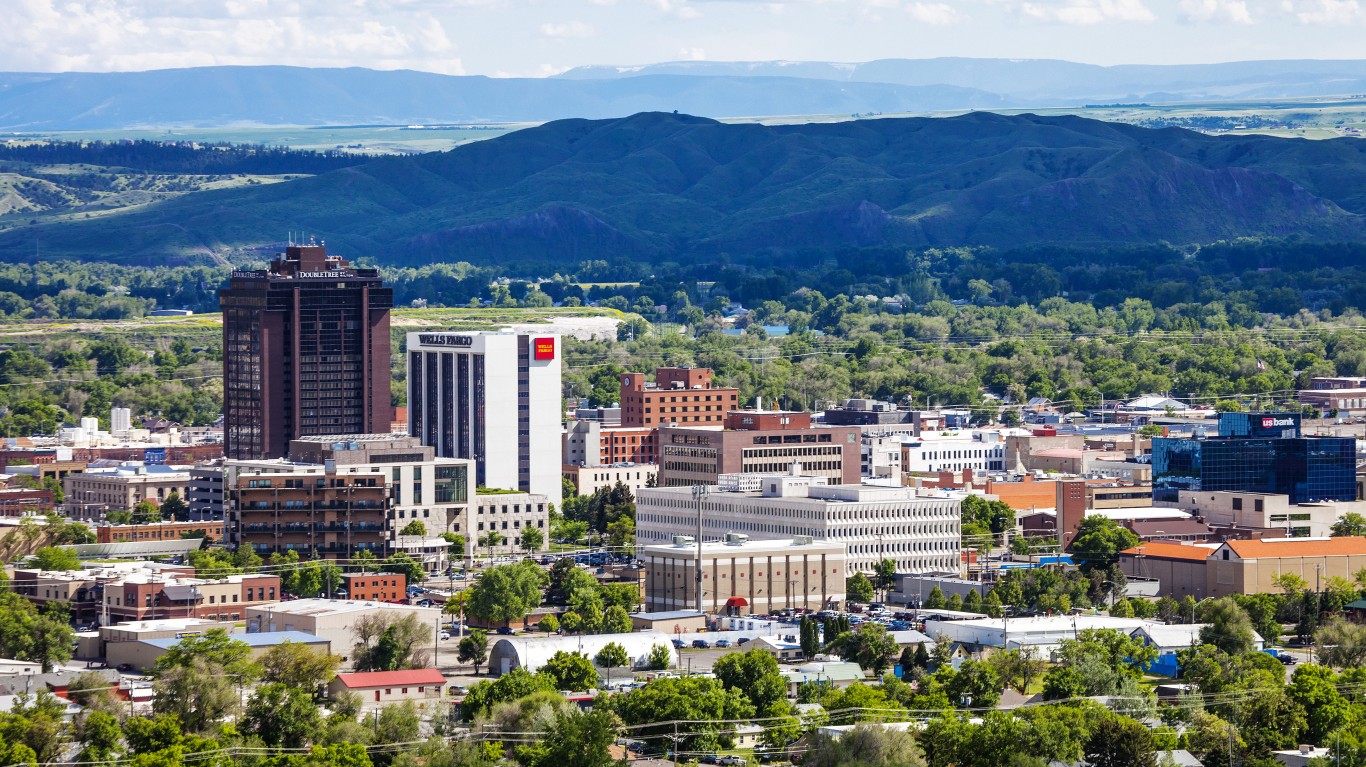
48. Montana
> Pre-COVID avg. weekly unemployment benefit payout: $379 (17th highest)
> Unemployment claims, mid-March through July 11: 125,703 (23.9% of labor force — 20th lowest)
> Employment change, June 2019 to June 2020: -4.8% (4th smallest decline)
> June 2020 unemployment rate: 7.1% (8th lowest)
On July 1, 2020, the Montana Department of Labor & Industry announced that unemployed residents who had exhausted their state and federal benefits are eligible for an additional 13 weeks of payments. Montana residents are also among the least likely to have lost their jobs during the pandemic. The jobless rate in the state as of June stands at 7.1%, one of the lowest state unemployment rates and well below the 11.1% national unemployment rate.
Likely due in part to a relatively resilient labor market and extended unemployment benefits, Montana residents are less likely than most Americans to be unable to afford basic necessities. According to a recent U.S. Census Bureau survey, just 13.5% of adults in the state cannot afford their monthly housing bills during the pandemic, well below the 25.3% share of adults nationwide who cannot.

47. Utah
> Pre-COVID avg. weekly unemployment benefit payout: $451 (8th highest)
> Unemployment claims, mid-March through July 11: 199,980 (12.6% of labor force — the lowest)
> Employment change, June 2019 to June 2020: -2.7% (the smallest decline)
> June 2020 unemployment rate: 5.1% (2nd lowest)
Utah’s job market has, so far, made it through the COVID-19 pandemic relatively unscathed. As of June, there were about 1.5 million people still working in the state, down 2.7% from the previous June, the smallest annual employment decline of any state. For those who have lost their jobs during the pandemic, Utah has waived its work search requirements for unemployment benefit recipiency.
Leading up to the pandemic, Utah’s average weekly payment to unemployment insurance recipients was $451 per week, higher than in most other states.
[in-text-ad-2]

46. Iowa
> Pre-COVID avg. weekly unemployment benefit payout: $394 (15th highest)
> Unemployment claims, mid-March through July 11: 390,695 (22.8% of labor force — 15th lowest)
> Employment change, June 2019 to June 2020: -7.4% (21st smallest decline)
> June 2020 unemployment rate: 8.0% (18th lowest)
Iowa is one of several states to institute a short-time compensation policy, meaning employers can reduce worker hours to avoid layoffs and affected workers are eligible for partial unemployment insurance benefits. Even before the pandemic, when the federal government instituted emergency increases in unemployment benefits of $600 a week, Iowa had one of the higher average weekly unemployment payouts among states, at nearly $400.
Iowa’s economy has also, so far, weathered the pandemic relatively well. The state’s 8.0% June unemployment rate is considerably lower than the 11.1% national rate.

45. Minnesota
> Pre-COVID avg. weekly unemployment benefit payout: $478 (4th highest)
> Unemployment claims, mid-March through July 11: 852,021 (27.6% of labor force — 22nd highest)
> Employment change, June 2019 to June 2020: -9.4% (20th largest decline)
> June 2020 unemployment rate: 8.6% (23rd lowest)
Over the months leading up to the COVID-19 pandemic, 73.1% of unemployed Minnesota residents received unemployment benefits, one of the highest recipiency rates among states. Now the recipiency rate is likely even higher, as the state has waived the work search requirement for laid off workers in certain circumstances. Minnesota has also implemented a short-time compensation policy, meaning employers can reduce worker hours to avoid layoffs and affected workers are eligible for partial unemployment insurance benefits.
In the months before the pandemic, the average weekly unemployment insurance benefit payout was $478 in Minnesota, more than in all but three other states. Now, during the pandemic, unemployed workers in all states receive an additional $600 per week.
[in-text-ad]
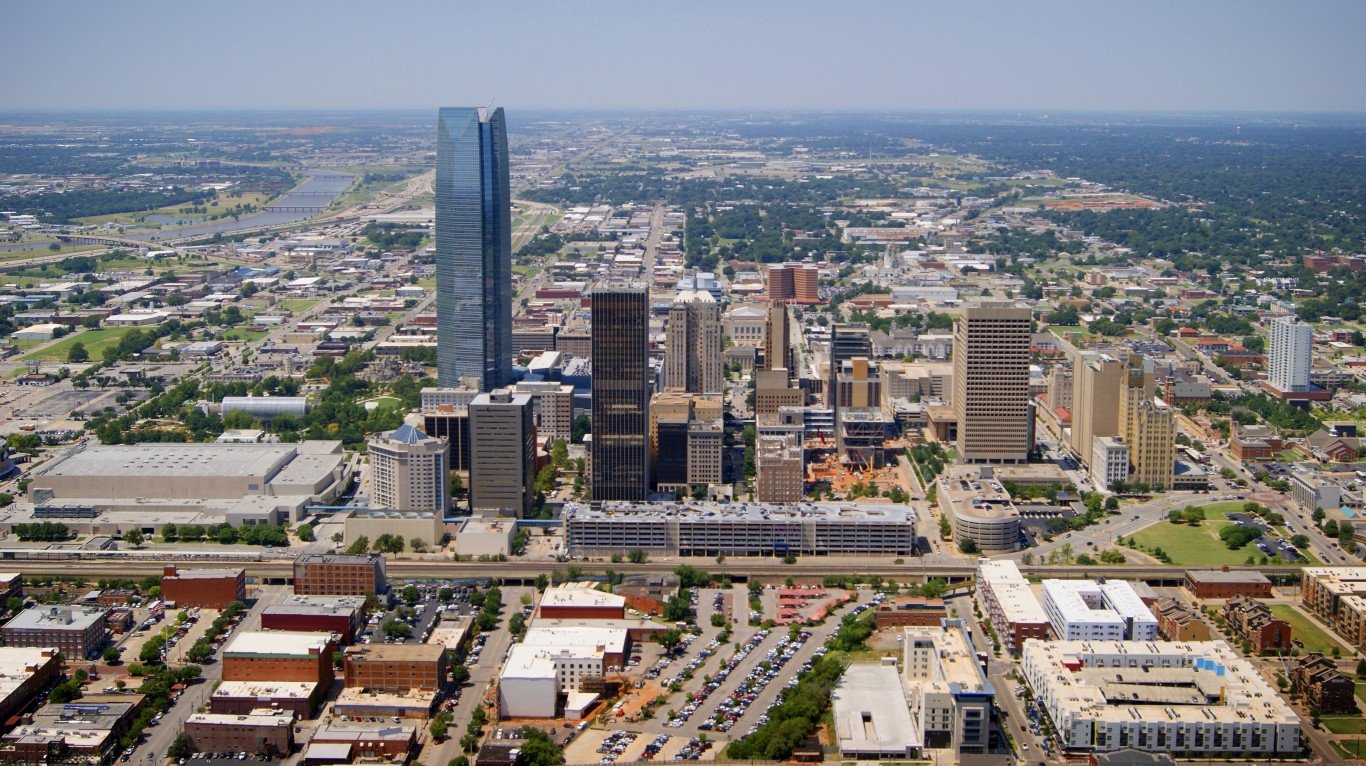
44. Oklahoma
> Pre-COVID avg. weekly unemployment benefit payout: $396 (14th highest)
> Unemployment claims, mid-March through July 11: 810,981 (44.2% of labor force — 5th highest)
> Employment change, June 2019 to June 2020: -5.7% (14th smallest decline)
> June 2020 unemployment rate: 6.6% (6th lowest)
Oklahoma has made it far easier for residents who lost their jobs to receive benefits during the COVID-19 pandemic. The state has waived both its one-week waiting period for benefit payouts as well as work-search requirements for beneficiaries. Labor force participants in Oklahoma are also far less likely than most to find themselves unemployed during the pandemic. The state’s June jobless rate of 6.6% is lower than the vast majority of states and well below the 11.1% national rate.
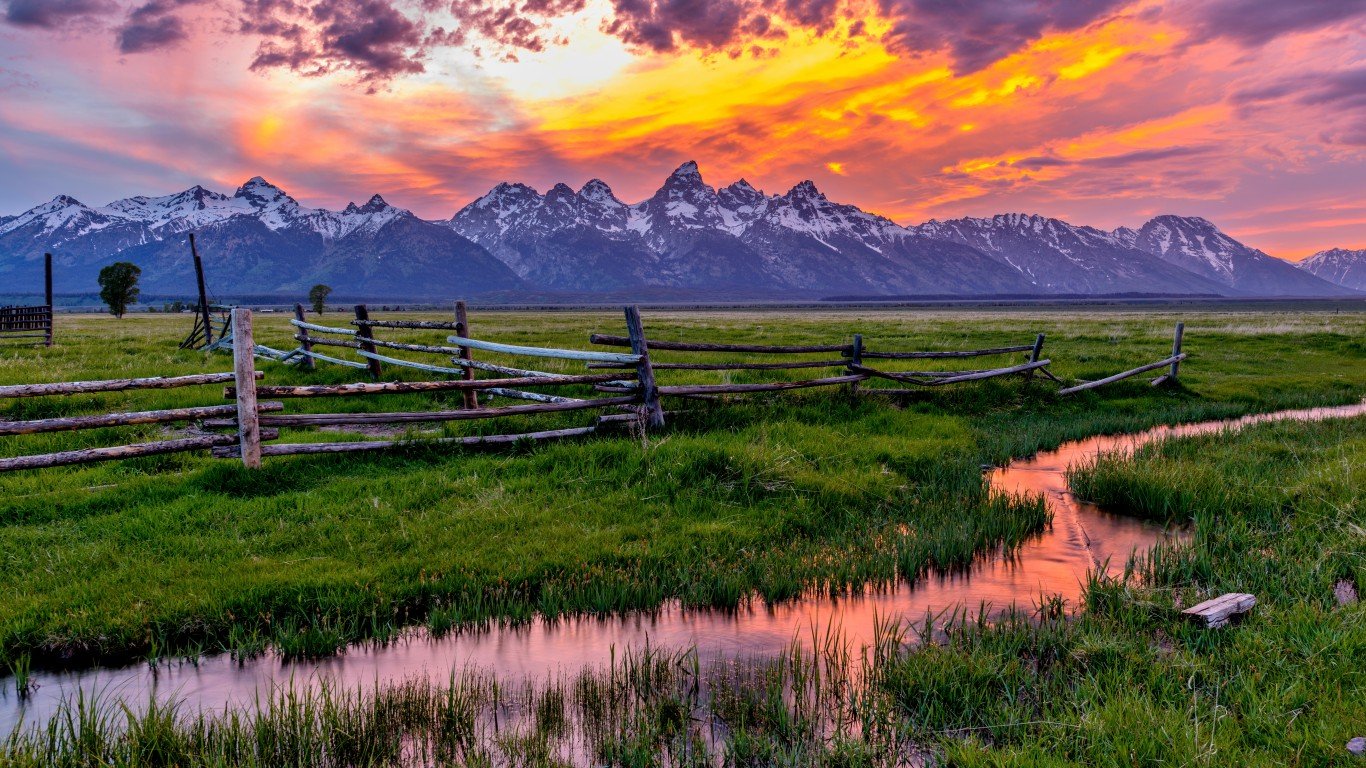
43. Wyoming
> Pre-COVID avg. weekly unemployment benefit payout: $419 (11th highest)
> Unemployment claims, mid-March through July 11: 52,825 (18.3% of labor force — 5th lowest)
> Employment change, June 2019 to June 2020: -7.6% (24th smallest decline)
> June 2020 unemployment rate: 7.6% (14th lowest)
Since mid-March, there have been about 53,000 initial unemployment claims in Wyoming, equal to 18.3% of the state’s total labor force, one of the smallest numbers of any state. As of June, the state’s official unemployment rate stands at 7.6%, well below the comparable 11.1% national rate.
In the months leading up to the pandemic, the average weekly unemployment payout in the state was $419, or about 49% of the average weekly wage in the state — the second highest replacement rate of any state.

42. Kentucky
> Pre-COVID avg. weekly unemployment benefit payout: $341 (20th lowest)
> Unemployment claims, mid-March through July 11: 1.1 million (53.0% of labor force — 2nd highest)
> Employment change, June 2019 to June 2020: -9.2% (21st largest decline)
> June 2020 unemployment rate: 4.3% (the lowest)
As of June, Kentucky has the strongest job market of any state in the country. Just 4.3% of workers in the state are unemployed, the lowest jobless rate of any state and in line with the state’s unemployment rate one year ago. Though there have been 1.1 million initial unemployment claims in the state since mid-March, a large share of those claimants have either been hired back or found other work. Many workers have also likely dropped out of the labor force, as there are about 178,000 fewer jobs in the state in June than there were the same month last year.
[in-text-ad-2]

41. Kansas
> Pre-COVID avg. weekly unemployment benefit payout: $392 (16th highest)
> Unemployment claims, mid-March through July 11: 338,406 (22.9% of labor force — 16th lowest)
> Employment change, June 2019 to June 2020: -5.5% (12th smallest decline)
> June 2020 unemployment rate: 7.5% (11th lowest)
Before the pandemic, the average unemployment insurance benefit payout in Kansas of $392 was higher than in most states. Kansas has waived both the requirement that unemployment benefit recipients continue their job search and the one-week waiting period for benefits to begin during the COVID-19 pandemic.

40. Maine
> Pre-COVID avg. weekly unemployment benefit payout: $359 (24th highest)
> Unemployment claims, mid-March through July 11: 193,221 (28.2% of labor force — 21st highest)
> Employment change, June 2019 to June 2020: -10.8% (10th largest decline)
> June 2020 unemployment rate: 6.6% (6th lowest)
Maine ranks as the best state in which to be unemployed in the Northeast and 11th best nationwide. Along with many other states, Maine has implemented a short-time compensation policy, meaning employers can reduce worker hours to avoid layoffs and affected workers are eligible for partial unemployment insurance benefits. This policy may explain why joblessness is less common in Maine than it is nationwide. The state’s June unemployment rate of 6.6% is lower than in most of the rest of the country.
[in-text-ad]

39. Nebraska
> Pre-COVID avg. weekly unemployment benefit payout: $351 (23rd lowest)
> Unemployment claims, mid-March through July 11: 166,570 (16.2% of labor force — 4th lowest)
> Employment change, June 2019 to June 2020: -5.0% (7th smallest decline)
> June 2020 unemployment rate: 6.7% (7th lowest)
Over the course of the pandemic, Nebraska has weathered the economic fallout relatively well. There have been 166,570 initial unemployment claims since mid-March, equal to 16.2% of the labor force, one of the smallest shares of any state. As of June, the official unemployment rate stands at 6.7% in Nebraska, below the vast majority of states.
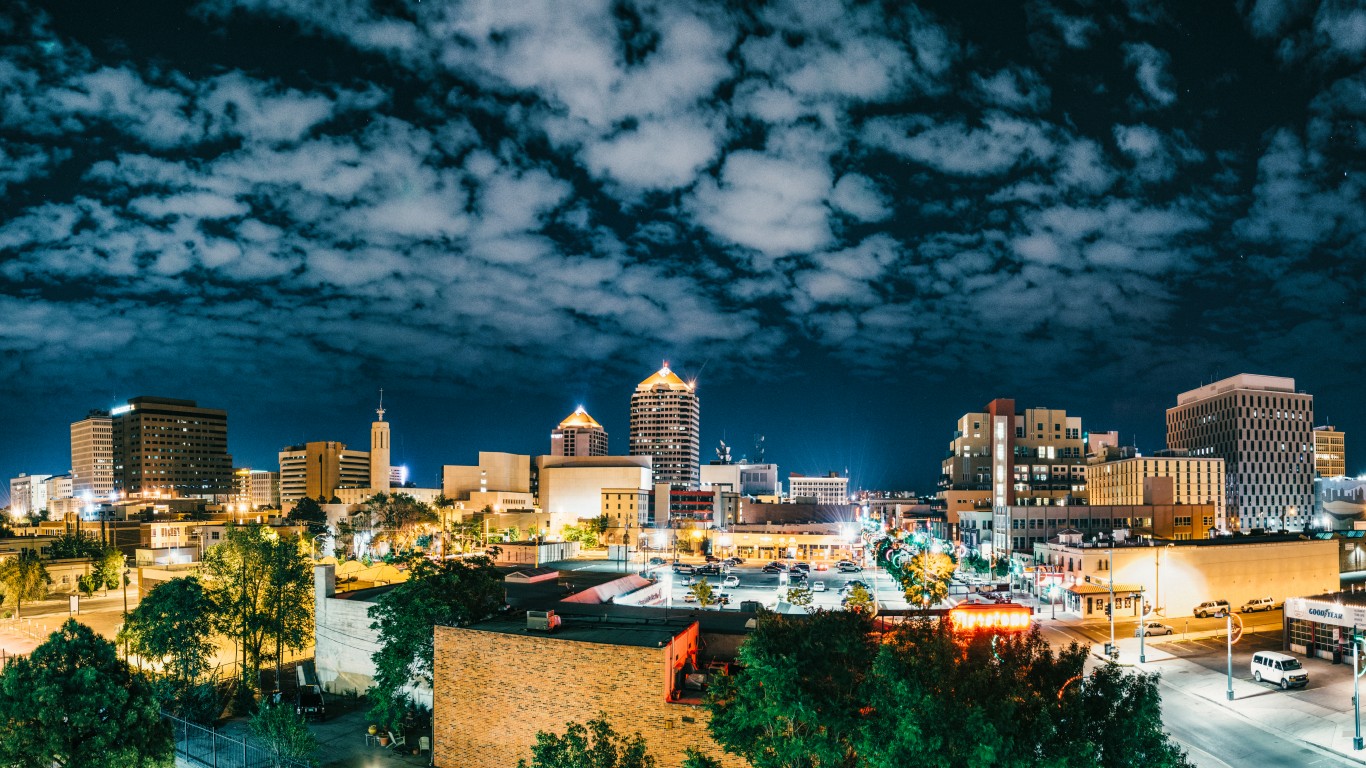
38. New Mexico
> Pre-COVID avg. weekly unemployment benefit payout: $343 (21st lowest)
> Unemployment claims, mid-March through July 11: 195,316 (20.6% of labor force — 7th lowest)
> Employment change, June 2019 to June 2020: -7.2% (19th smallest decline)
> June 2020 unemployment rate: 8.3% (19th lowest)
Over the year leading up to the COVID-19 pandemic, the average unemployment insurance benefit payout in New Mexico was $343, lower than in most states, but equal to 47.8% of average weekly wages among workers in the state. Now, with the additional $600 in unemployment benefits Americans are being paid through the end of July, many of those out of work in the state are likely making more than they would have if they were still employed, at least until that additional benefit expires.

37. South Dakota
> Pre-COVID avg. weekly unemployment benefit payout: $359 (23rd highest)
> Unemployment claims, mid-March through July 11: 58,652 (12.8% of labor force — 2nd lowest)
> Employment change, June 2019 to June 2020: -5.4% (10th smallest decline)
> June 2020 unemployment rate: 7.2% (9th lowest)
Since mid-March, when the COVID-19 pandemic began taking an economic toll, there have been about 59,000 initial unemployment claims in South Dakota, equal to 12.8% of the state’s total labor force, nearly the smallest share of any state in the country. Additionally, before the pandemic, only about 15% of unemployment benefit recipients in the state exhausted those benefits before finding a job, one of the smallest shares of any state in the country.
[in-text-ad-2]
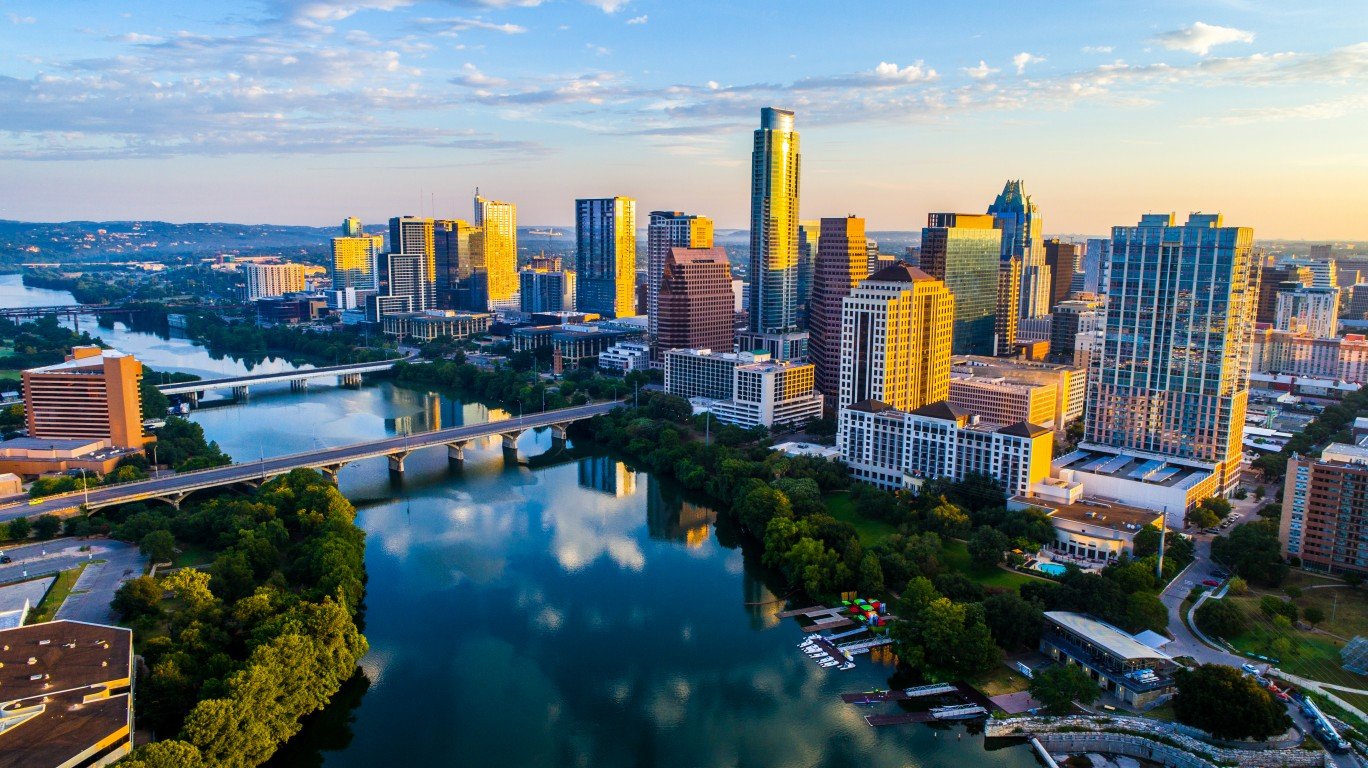
36. Texas
> Pre-COVID avg. weekly unemployment benefit payout: $427 (9th highest)
> Unemployment claims, mid-March through July 11: 2.9 million (20.8% of labor force — 8th lowest)
> Employment change, June 2019 to June 2020: -5.4% (11th smallest decline)
> June 2020 unemployment rate: 8.6% (23rd lowest)
Texas is one of several states to institute a short-time compensation policy, meaning employers can reduce worker hours to avoid layoffs and affected workers are eligible for partial unemployment insurance benefits. This may partially explain why Texas’s unemployment rate of 8.6% is considerably lower than the comparable 11.1% national rate.
Even before the pandemic, when the federal government instituted emergency increases in unemployment benefits of $600 a week, Texas had one of the higher average weekly unemployment payouts among states, at $427.

35. Vermont
> Pre-COVID avg. weekly unemployment benefit payout: $360 (22nd highest)
> Unemployment claims, mid-March through July 11: 79,502 (23.1% of labor force — 18th lowest)
> Employment change, June 2019 to June 2020: -13.1% (5th largest decline)
> June 2020 unemployment rate: 9.4% (25th highest)
Vermont has some of the least restrictive unemployment benefit policies of any state during the COVID-19 pandemic. Workers who left their job due to risk of exposure, to care for sick or isolated family members due to the virus, or to care for a child whose school was closed may be eligible for unemployment benefits. Vermont has also waived its work search requirement for those receiving unemployment benefits.
Though Vermont has a strong social safety net, few states have seen a decline in employment as dramatic as Vermont. As of June, there were 275,000 people employed in the state, a 13.1% decline from the same month the previous year, nearly the largest decline among states.
[in-text-ad]

34. Connecticut
> Pre-COVID avg. weekly unemployment benefit payout: $407 (13th highest)
> Unemployment claims, mid-March through July 11: 458,674 (24.2% of labor force — 23rd lowest)
> Employment change, June 2019 to June 2020: -10.3% (13th largest decline)
> June 2020 unemployment rate: 9.8% (21st highest)
During the months leading up to the COVID-19 outbreak, about 60% of unemployed Connecticut residents received unemployment insurance benefits, a higher recipiency rate than most states. The recipiency rate is likely even higher now as the state waived the requirement that benefit recipients be actively looking for work during the pandemic.
Job losses have surged in Connecticut during the pandemic. Overall employment fell by 10.3% in Connecticut, while nationwide, 8.6% of jobs have disappeared so far.
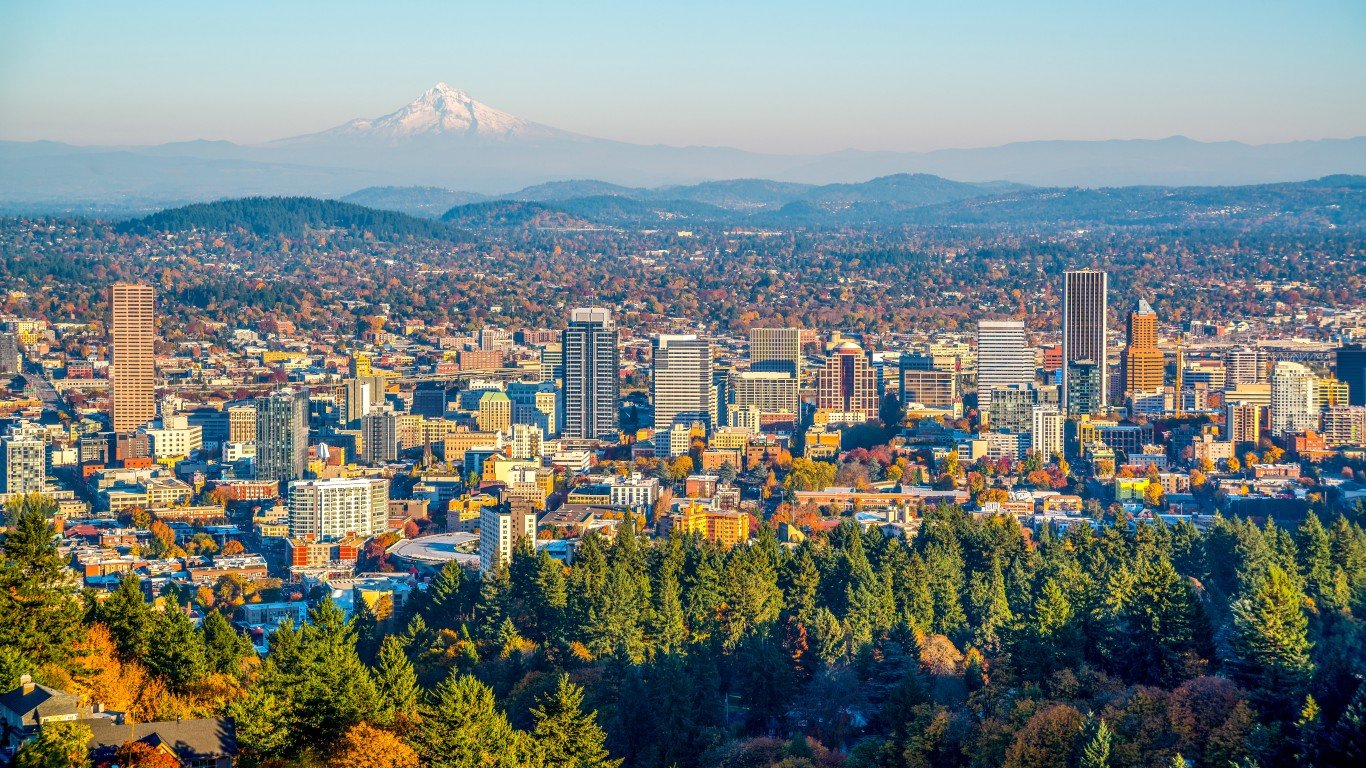
33. Oregon
> Pre-COVID avg. weekly unemployment benefit payout: $424 (10th highest)
> Unemployment claims, mid-March through July 11: 542,352 (25.8% of labor force — 25th highest)
> Employment change, June 2019 to June 2020: -8.6% (25th largest decline)
> June 2020 unemployment rate: 11.2% (14th highest)
The economic effect of the COVID-19 pandemic in Oregon has been closely in line with its overall effect nationwide. In Oregon, 11.2% of the labor force is unemployed — compared to the 11.1% U.S. jobless rate. Similarly, the number of people working in Oregon fell by 8.6% from June 2019 to June 2020, the same decline reported across the U.S. as a whole.
In an effort to reduce joblessness, Oregon implemented a short-time compensation policy, whereby employers can reduce worker hours to avoid layoffs, and affected workers are eligible for partial unemployment insurance benefits. For those who lost their jobs, the standard one-week waiting period for benefits to kick in has been waived during the pandemic.

32. Washington
> Pre-COVID avg. weekly unemployment benefit payout: $527 (2nd highest)
> Unemployment claims, mid-March through July 11: 1.5 million (37.6% of labor force — 7th highest)
> Employment change, June 2019 to June 2020: -9.0% (22nd largest decline)
> June 2020 unemployment rate: 9.8% (21st highest)
Leading up to the pandemic, the average weekly unemployment benefit payout in Washington was $527. While this is the second highest payment among states, it only covered about 41% of the average working wage in the state, which is not an especially high replacement rate, relative to most states.
Although Washington has had some of the most initial unemployment claims of any state relative to the size of its workforce, its economy has weathered the COVID-19 pandemic relatively well. As of June, Washington’s unemployment rate stood at 9.8%, slightly below the 11.1% national jobless rate.
[in-text-ad-2]
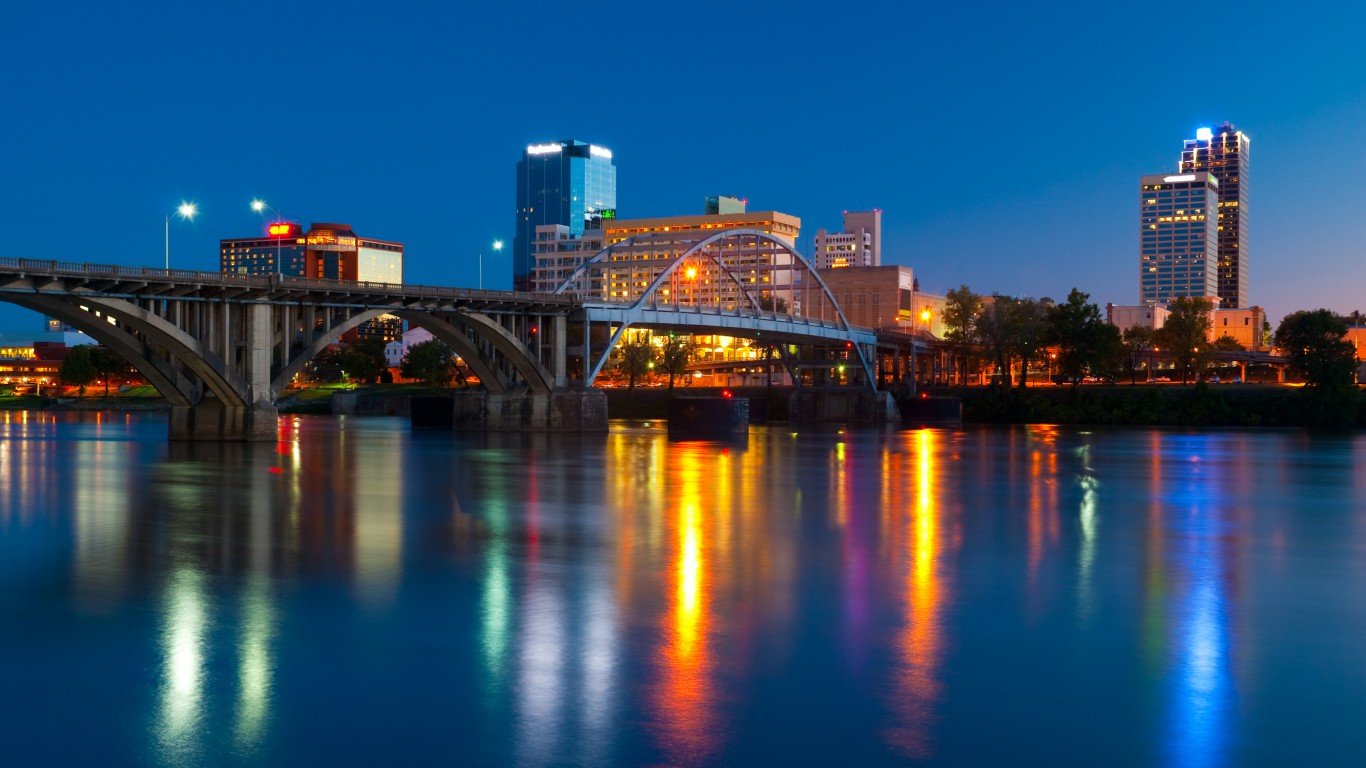
31. Arkansas
> Pre-COVID avg. weekly unemployment benefit payout: $270 (9th lowest)
> Unemployment claims, mid-March through July 11: 299,227 (22.1% of labor force — 12th lowest)
> Employment change, June 2019 to June 2020: -5.1% (8th smallest decline)
> June 2020 unemployment rate: 8.0% (18th lowest)
Like Americans in other states, eligible Arkansas residents who are out of work are receiving an additional $600 per week in unemployment benefits during the pandemic through the end of July. However, in the months leading up to the current economic crisis, Arkansas’ benefits were some of smallest of any state. The average weekly unemployment payout in the state was just $270, lower than the vast majority of states.
Arkansas’s economy has, so far, weathered COVID-19 pandemic better than most of the country. The state’s jobless rate of 8.0% is considerably lower than the 11.1% national unemployment rate.
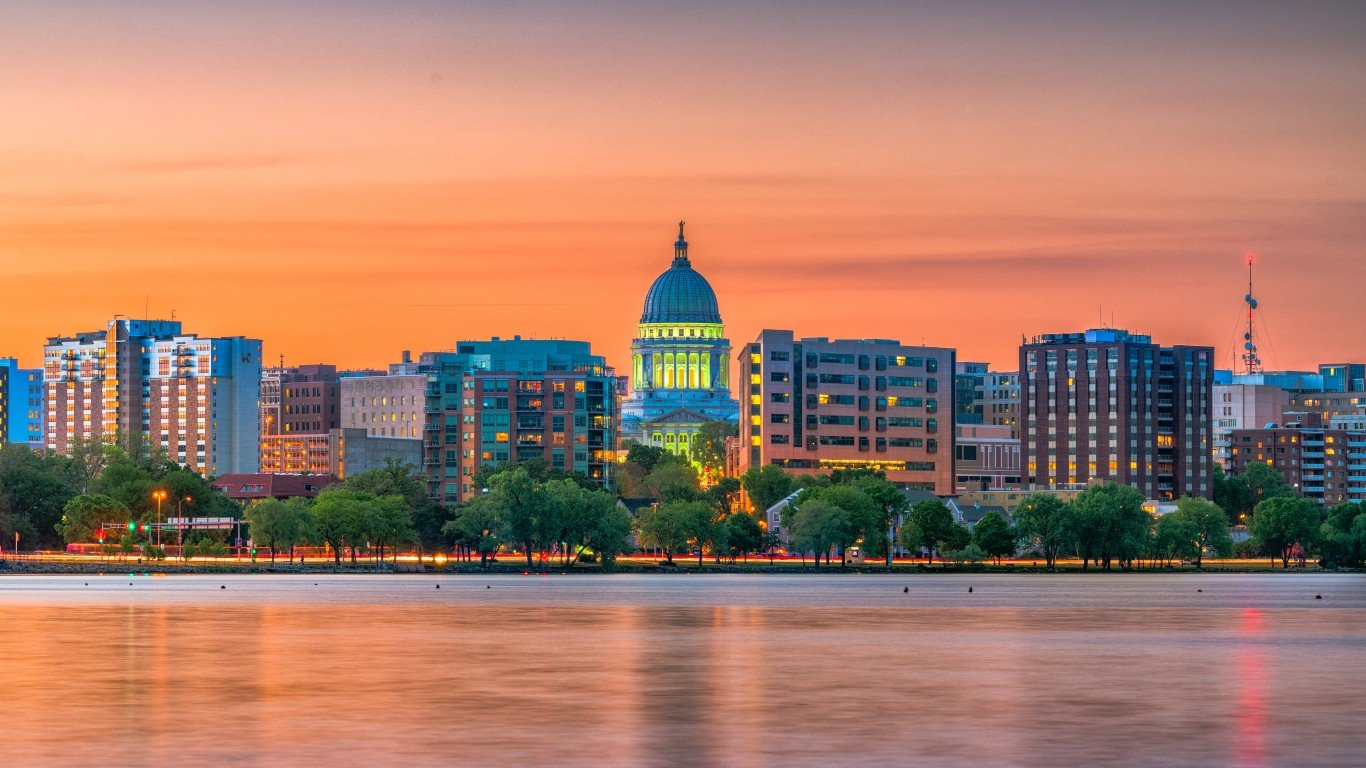
30. Wisconsin
> Pre-COVID avg. weekly unemployment benefit payout: $324 (16th lowest)
> Unemployment claims, mid-March through July 11: 768,779 (24.8% of labor force — 24th lowest)
> Employment change, June 2019 to June 2020: -9.8% (17th largest decline)
> June 2020 unemployment rate: 8.5% (21st lowest)
Leading up to the current economic crisis, the average unemployment insurance payout in Wisconsin was $324 per week, less than in most states and enough to cover only about 38% of the average weekly working wage — one of the lower replacement rates among states.
Unlike nearly every other state, newly unemployed Wisconsin residents are still subject to a one-week waiting period before they begin receiving benefits.
[in-text-ad]

29. Pennsylvania
> Pre-COVID avg. weekly unemployment benefit payout: $408 (12th highest)
> Unemployment claims, mid-March through July 11: 2.3 million (35.2% of labor force — 9th highest)
> Employment change, June 2019 to June 2020: -10.2% (14th largest decline)
> June 2020 unemployment rate: 13.0% (9th highest)
By measures of total employment, Pennsylvania’s economy has been hit harder by the COVID-19 pandemic than the economy of most other states. Between June of 2019 and June of 2020, about one in every 10 jobs in the state has disappeared. Pennsylvania’s June unemployment rate stands at 13.0%, compared to the 11.1% U.S. jobless rate.
Pennsylvania’s jobless rate would likely be higher had it it not implemented a short-time compensation policy. This policy allows employers to reduce worker hours to avoid layoffs while allowing affected workers to claim partial unemployment insurance benefits.

28. Colorado
> Pre-COVID avg. weekly unemployment benefit payout: $458 (7th highest)
> Unemployment claims, mid-March through July 11: 502,463 (16.1% of labor force — 3rd lowest)
> Employment change, June 2019 to June 2020: -6.6% (18th smallest decline)
> June 2020 unemployment rate: 10.5% (17th highest)
In the months preceding the COVID-19 pandemic, just over 40% of unemployment insurance beneficiaries in Colorado had exhausted their benefits before finding employment again — one of the higher exhaustion rates in the country. Since the start of the pandemic, Colorado has extended the maximum length of its benefits period to 39 weeks to account for mass disruptions in its job market. As of mid-March, there have been over half a million initial jobless claims filed in the state.

27. Maryland
> Pre-COVID avg. weekly unemployment benefit payout: $358 (25th highest)
> Unemployment claims, mid-March through July 11: 777,534 (24.1% of labor force — 22nd lowest)
> Employment change, June 2019 to June 2020: -9.5% (19th largest decline)
> June 2020 unemployment rate: 8.0% (18th lowest)
Before the pandemic sent shockwaves through the U.S. economy, only about 29% of unemployed Maryland residents received unemployment insurance benefits, a lower recipiency rate than in most states. That rate has likely increased in recent months however, as Maryland has taken several measures to make it easier for out-of-work state residents to receive benefits, including waiving the requirement that recipients be actively searching for work.
Maryland’s job market has been devastated by the COVID-19 pandemic. Between June of 2019 and June of 2020, about one in every 10 jobs in the state have disappeared.
[in-text-ad-2]

26. Georgia
> Pre-COVID avg. weekly unemployment benefit payout: $306 (14th lowest)
> Unemployment claims, mid-March through July 11: 3.1 million (61.6% of labor force — the highest)
> Employment change, June 2019 to June 2020: -5.2% (9th smallest decline)
> June 2020 unemployment rate: 7.6% (14th lowest)
In Georgia, the average weekly unemployment insurance payout was just $306 before the pandemic, less than in most states and enough to cover only about one-third of the average weekly working wage in the state. Since the pandemic however, qualified residents who are out of work are benefiting from an additional $600 in federal benefits per week, at least until the end of July.
Though there have been over three million initial unemployment filings in Georgia since mid-March — equal to a staggering 61.6% of the state’s total labor force — many of those who filed for unemployment have likely since found work again. As of June, Georgia’s official unemployment rate stands at 7.6%, considerably lower than the 11.1% national unemployment rate.
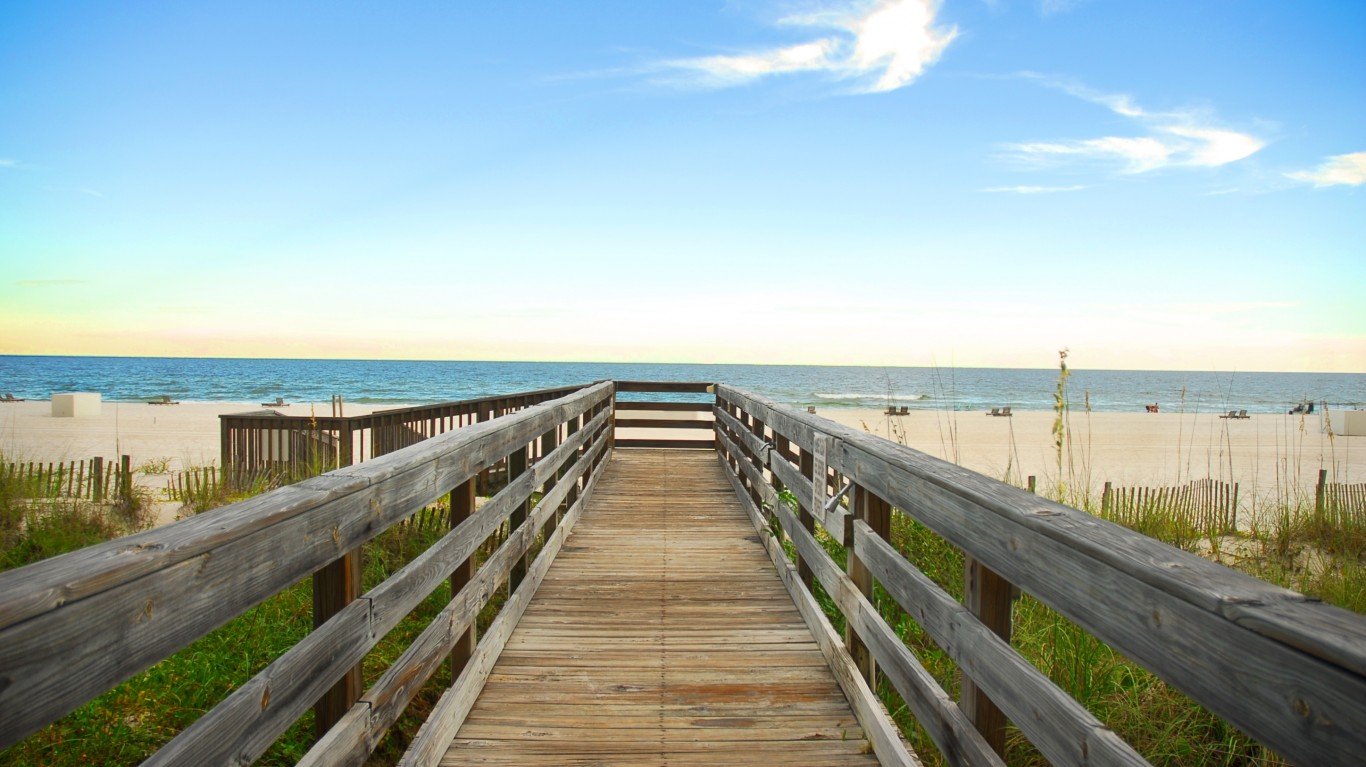
25. Alabama
> Pre-COVID avg. weekly unemployment benefit payout: $234 (3rd lowest)
> Unemployment claims, mid-March through July 11: 662,139 (29.5% of labor force — 19th highest)
> Employment change, June 2019 to June 2020: -5.5% (13th smallest decline)
> June 2020 unemployment rate: 7.5% (11th lowest)
The average weekly unemployment insurance payout was just $243 in Alabama before the pandemic, nearly the lowest in the country and enough to cover only about one-third of the average weekly working wage in the state. With the additional $600 per week eligible jobless residents are receiving during the pandemic, many who are out of work are making more than three times what they otherwise would earn.
Alabama’s relatively low 7.5% unemployment rate would likely be higher had the state not implemented a short-time compensation policy. This policy allows employers to reduce worker hours to avoid layoffs, while allowing affected workers to claim partial unemployment insurance benefits.
[in-text-ad]

24. South Carolina
> Pre-COVID avg. weekly unemployment benefit payout: $276 (11th lowest)
> Unemployment claims, mid-March through July 11: 685,570 (29.0% of labor force — 20th highest)
> Employment change, June 2019 to June 2020: -5.8% (15th smallest decline)
> June 2020 unemployment rate: 8.7% (25th lowest)
South Carolina is one of only a dozen states where, in the months leading up to the pandemic, the average weekly payout for unemployment insurance was less than $300. With the additional $600 per week eligible jobless residents are receiving during the pandemic, many who are out of work in the state are making more than three times what they otherwise would have.
During the pandemic, South Carolina has also waived a law requiring those receiving unemployment benefits to continue searching for work. This may have boosted South Carolina’s overall recipiency rate. Before that rule was waived, only 29.0% of unemployed residents were receiving unemployment benefits.

23. Rhode Island
> Pre-COVID avg. weekly unemployment benefit payout: $362 (21st highest)
> Unemployment claims, mid-March through July 11: 192,162 (34.8% of labor force — 10th highest)
> Employment change, June 2019 to June 2020: -11.8% (7th largest decline)
> June 2020 unemployment rate: 12.4% (11th highest)
As is the case in much of the Northeast, Rhode Island’s economy has been hit hard by the COVID-19 pandemic. More than one in every 10 jobs that existed in the state in June 2019 is gone as of June 2020, and the official unemployment rate stands at 12.4%, compared to the 11.1% national rate.
During the pandemic, Rhode Island has waived several restrictions for accessing unemployment benefits. For example, residents may be eligible if they have to leave work to care for their children due to illness or school closure, and benefit recipients no longer have to be actively searching for work.

22. West Virginia
> Pre-COVID avg. weekly unemployment benefit payout: $329 (18th lowest)
> Unemployment claims, mid-March through July 11: 181,686 (23.0% of labor force — 17th lowest)
> Employment change, June 2019 to June 2020: -7.8% (25th smallest decline)
> June 2020 unemployment rate: 10.4% (18th highest)
West Virginia has waived several restrictions for accessing unemployment benefits during the pandemic. For example, residents may be eligible if they have to leave work to care for their children due to illness or school closure and benefit recipients no longer have to be actively searching for work.
Still, West Virginia is not doing as much as many other states, as it has not implemented a short-time compensation policy, which would allow employers to reduce worker hours to avoid layoffs, while allowing affected workers to claim partial unemployment insurance benefits. Such a policy would likely reduce West Virginia’s 10.4% unemployment rate.
[in-text-ad-2]
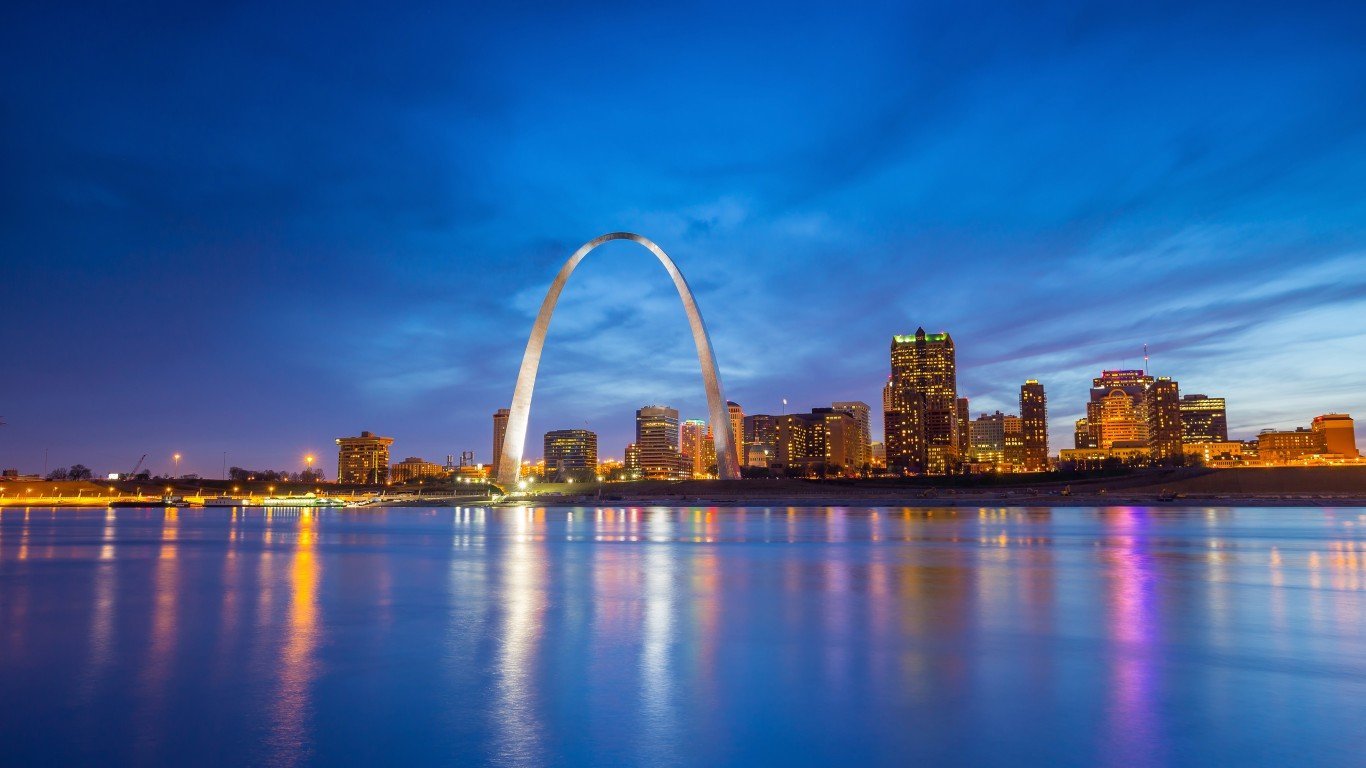
21. Missouri
> Pre-COVID avg. weekly unemployment benefit payout: $268 (8th lowest)
> Unemployment claims, mid-March through July 11: 720,688 (23.5% of labor force — 19th lowest)
> Employment change, June 2019 to June 2020: -7.2% (20th smallest decline)
> June 2020 unemployment rate: 7.9% (15th lowest)
Missouri is one of only a dozen states where, in the months leading up to the pandemic, the average weekly payout for unemployment insurance was less than $300. For many residents receiving weekly unemployment checks, the additional $600 will more than triple what they would normally receive.
Before the pandemic, only about one-quarter of unemployed Missouri residents were receiving weekly benefits. That rate might have increased in recent months, as the state waived its work-search requirements for recipients.

20. Mississippi
> Pre-COVID avg. weekly unemployment benefit payout: $212 (the lowest)
> Unemployment claims, mid-March through July 11: 407,388 (32.1% of labor force — 13th highest)
> Employment change, June 2019 to June 2020: -4.9% (5th smallest decline)
> June 2020 unemployment rate: 8.7% (25th lowest)
The average weekly unemployment payout in Mississippi was $212 before the pandemic, the lowest among states. Even with the additional $600 eligible jobless residents are receiving every week during the pandemic, affording basic necessities may be difficult. According to a recent survey conducted by the U.S. Census Bureau, 37.1% of adults in Mississippi recently missed a monthly rent or mortgage payment, or would likely soon miss one — the largest share of any state in the country.
Still, workers in Mississippi are less likely to be unemployed during the pandemic than most Americans in the labor force. As of June, Mississippi’s unemployment rate of 8.7% was well below the 11.1% national rate.
[in-text-ad]

19. Virginia
> Pre-COVID avg. weekly unemployment benefit payout: $322 (15th lowest)
> Unemployment claims, mid-March through July 11: 981,507 (22.4% of labor force — 14th lowest)
> Employment change, June 2019 to June 2020: -7.6% (23rd smallest decline)
> June 2020 unemployment rate: 8.4% (20th lowest)
Before the pandemic, only about 22% of jobless Virginia residents actually received unemployment benefits, one of the smallest shares of any state. That number has likely climbed in recent months however, as Virginia temporarily waived a law requiring benefit recipients to actively search for work.
Still, Virginia is not doing as much as many other states, as it has not implemented a short-term compensation policy, which enables employers to reduce worker hours to avoid layoffs, while allowing affected workers to claim partial unemployment insurance benefits. Such a policy would likely reduce the state’s unemployment rate.
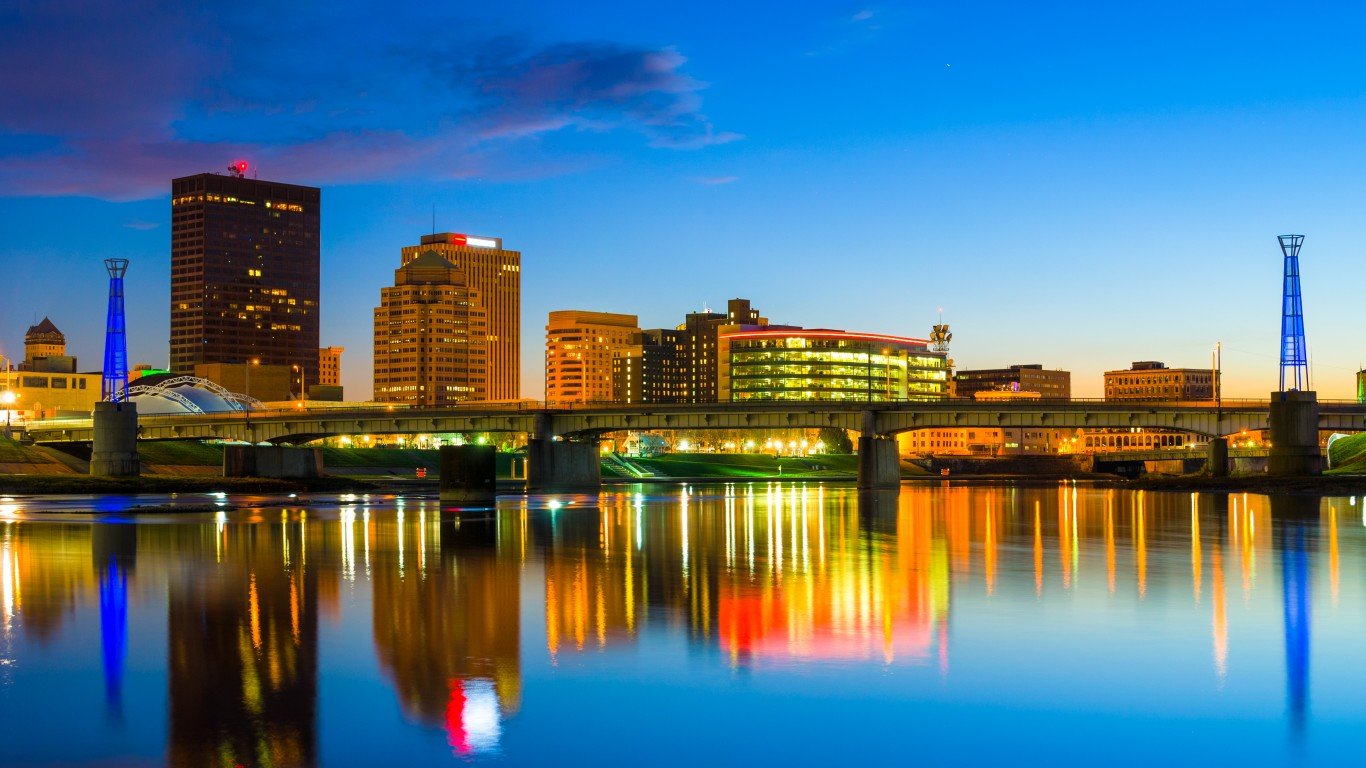
18. Ohio
> Pre-COVID avg. weekly unemployment benefit payout: $364 (20th highest)
> Unemployment claims, mid-March through July 11: 1.5 million (26.2% of labor force — 24th highest)
> Employment change, June 2019 to June 2020: -9.9% (16th largest decline)
> June 2020 unemployment rate: 10.9% (16th highest)
The average weekly unemployment payout in Ohio was $364 before the pandemic, more than in most states. Still, even with the additional $600 eligible jobless Americans are receiving every week during the pandemic, affording basic necessities may be difficult for many in the state. According to a recent survey conducted by the U.S. Census Bureau, 17.2% of adults in Ohio are in households where there has not been enough to eat in the last week — the third largest share of any state in the country.
Ohio’s job market has been hit harder than most states by the pandemic. More than one in every 10 jobs that existed in the state in June 2019 was gone by June 2020.

17. New Jersey
> Pre-COVID avg. weekly unemployment benefit payout: $460 (5th highest)
> Unemployment claims, mid-March through July 11: 1.4 million (30.8% of labor force — 17th highest)
> Employment change, June 2019 to June 2020: -13.4% (4th largest decline)
> June 2020 unemployment rate: 16.6% (2nd highest)
Between June 2019 and June 2020 overall employment fell by 13.4% in New Jersey, a larger decline than in all but three other states. The state’s official unemployment rate of 16.6% is the second worst in the country and well above the 11.1% national rate. Despite the magnitude of the problem, New Jersey has not reduced as many barriers to accessing unemployment benefits as many other states. Along with Alaska and New York, New Jersey is one of only three states to not temporarily waive the requirement that unemployment beneficiaries be actively searching for work.
[in-text-ad-2]

16. Massachusetts
> Pre-COVID avg. weekly unemployment benefit payout: $521 (3rd highest)
> Unemployment claims, mid-March through July 11: 1.1 million (29.5% of labor force — 18th highest)
> Employment change, June 2019 to June 2020: -14.4% (3rd largest decline)
> June 2020 unemployment rate: 17.4% (the highest)
The job market in Massachusetts ranks as the worst in the country. The state’s 17.4% unemployment rate is higher than every other state and well above the 11.1% national jobless rate.
However, for the 1.1 million Massachusetts residents who have filed an unemployment claim since the beginning of the pandemic, the state also has a relatively strong social safety net in place. The average weekly unemployment payout in the state is $521, nearly the highest in the country. When coupled with the additional $600 qualified jobless Americans can receive every week during the pandemic through the end of July, weekly income for some unemployed Massachusetts residents is closely in line with the state’s average weekly working wage.
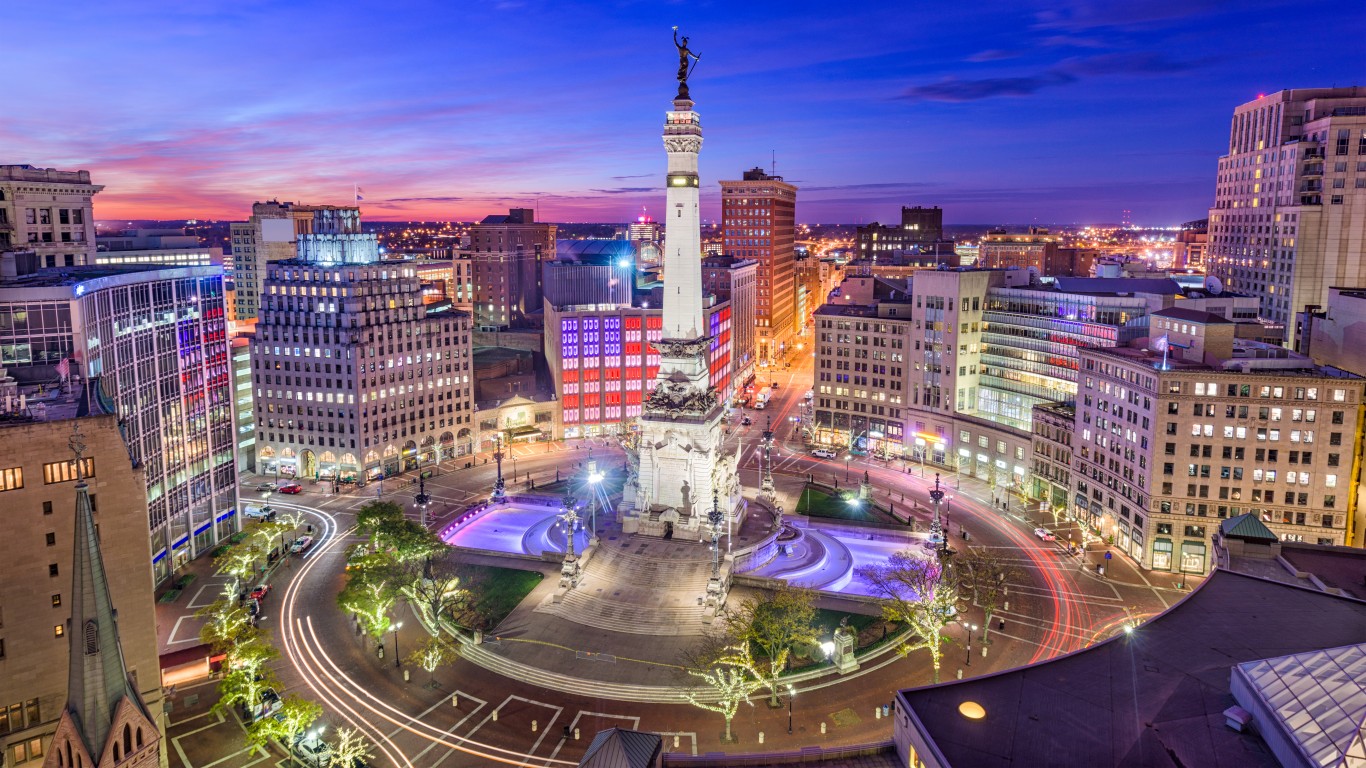
15. Indiana
> Pre-COVID avg. weekly unemployment benefit payout: $300 (13th lowest)
> Unemployment claims, mid-March through July 11: 893,259 (26.3% of labor force — 23rd highest)
> Employment change, June 2019 to June 2020: -6.4% (17th smallest decline)
> June 2020 unemployment rate: 11.2% (14th highest)
Before the additional $600 in weekly unemployment benefits began being distributed during the COVID-19 pandemic, the average weekly payout among eligible Indiana residents was $300 — less than in most states and enough to cover only about one-third of the average weekly working wage in the state. Access to those benefits is likely also more difficult than in most states as only about 34% of unemployed residents received them, compared to the 37% national recipiency rate.
Indiana’s job market has closely resembled that of the U.S. as a whole during the pandemic. The state’s official June unemployment rate of 11.2% is closely in line with the 11.1% national average.
[in-text-ad]
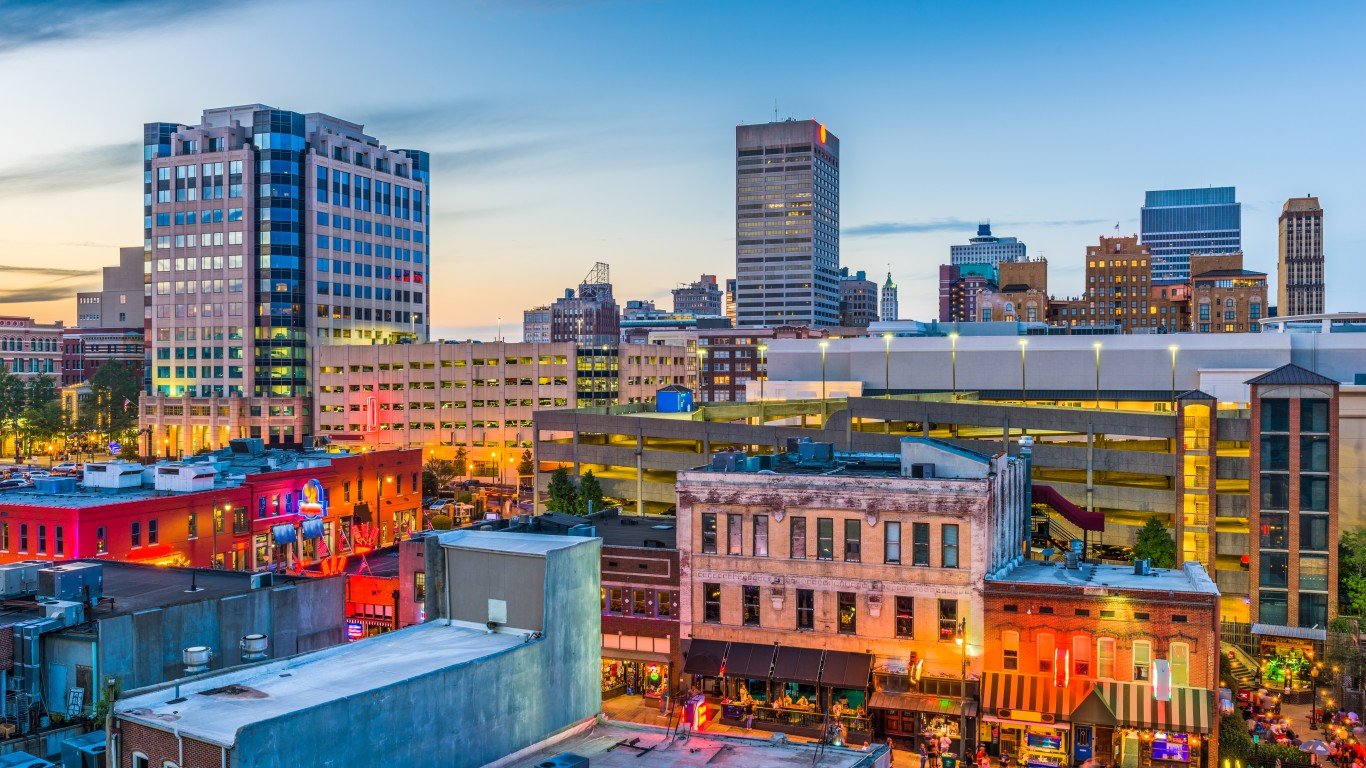
14. Tennessee
> Pre-COVID avg. weekly unemployment benefit payout: $243 (5th lowest)
> Unemployment claims, mid-March through July 11: 696,916 (21.0% of labor force — 10th lowest)
> Employment change, June 2019 to June 2020: -4.9% (6th smallest decline)
> June 2020 unemployment rate: 9.7% (23rd highest)
Tennessee is one of only a dozen states where, in the months leading up to the pandemic, the average weekly payout for unemployment insurance was less than $300. For many residents receiving weekly unemployment checks, the additional $600 per week will more than triple what they would normally receive.
Though Tennessee’s jobless rate of 9.7% is slightly lower than average, it could have likely been even lower through more aggressive policies. Tennessee is one of the states that does not have a standing short-term compensation policy, which allows employers to reduce worker hours to avoid layoffs, while permitting affected workers to claim partial unemployment insurance benefits.

13. North Carolina
> Pre-COVID avg. weekly unemployment benefit payout: $275 (10th lowest)
> Unemployment claims, mid-March through July 11: 1.2 million (23.9% of labor force — 21st lowest)
> Employment change, June 2019 to June 2020: -7.4% (22nd smallest decline)
> June 2020 unemployment rate: 7.6% (14th lowest)
Before the additional $600 in weekly unemployment benefits began being distributed during the COVID-19 pandemic, the average weekly payout among eligible North Carolinians was $275 — enough to cover less than one-third of the $849 average weekly working wage in the state.
Accessing those benefits appears to be more difficult in North Carolina than in much of the rest of the country as well. Only 14.4% of unemployed North Carolinians receive benefits, compared to 36.7% of unemployed Americans nationwide. Of those who do receive benefits, nearly half exhaust them before finding work, compared to a national exhaustion rate of 35%.

12. Hawaii
> Pre-COVID avg. weekly unemployment benefit payout: $534 (the highest)
> Unemployment claims, mid-March through July 11: 296,150 (44.5% of labor force — 4th highest)
> Employment change, June 2019 to June 2020: -16.0% (the largest decline)
> June 2020 unemployment rate: 13.9% (8th highest)
Hawaii’s economy, which depends heavily on tourism, has been hit hard by COVID-19. Overall employment fell by a nation-leading 16.0% between June 2019 and June 2020. Though the state has the highest average weekly unemployment benefit payout in the country, it may not be enough to match the economic challenges residents face — even with the additional $600 per week qualified unemployed Americans are receiving during the pandemic. Across Hawaii, a staggering 61.6% of adults are in households that have lost at least some employment income since mid-March, the largest share of any state.
[in-text-ad-2]

11. Nevada
> Pre-COVID avg. weekly unemployment benefit payout: $375 (18th highest)
> Unemployment claims, mid-March through July 11: 557,821 (36.4% of labor force — 8th highest)
> Employment change, June 2019 to June 2020: -10.5% (11th largest decline)
> June 2020 unemployment rate: 15.0% (4th highest)
Nevada’s economy, largely driven by tourism to Las Vegas, was one of the most severely impacted by COVID-19. It is the only state in which over a third of those employed before the pandemic were in high-risk industries, nearly double the U.S. rate. Nearly 60% of adults live in a household in which someone lost employment income since mid-March, compared to just under half of all U.S. adults. Nevada’s 15.0% unemployment rate for June 2020 is the fourth highest in the country. Employment in the state fell 10.5% from June 2019, a greater decline than in all but 10 other states.
Prior to the pandemic, Nevada’s $375 average weekly unemployment insurance benefit was higher than in most states. It also replaced 41.5% of the state’s average weekly wage, a larger share than the 38.3% national average.

10. Arizona
> Pre-COVID avg. weekly unemployment benefit payout: $235 (4th lowest)
> Unemployment claims, mid-March through July 11: 783,745 (22.3% of labor force — 13th lowest)
> Employment change, June 2019 to June 2020: -3.3% (3rd smallest decline)
> June 2020 unemployment rate: 10.0% (20th highest)
Arizona ranks as one of the 10 worst states to be unemployed in part because of the relatively meager unemployment benefits that are available to residents. Before the pandemic the average weekly unemployment benefit amounted to just $235, lower than all but three other states. This amount replaced just 30.6% of Arizona’s average weekly wage, one of the lowest shares in the country. Just 11.1% of unemployed Arizona residents receive benefits — less than a third of the U.S. rate, and the second lowest percentage of any state.
However, Arizona did waive the typical seven-day waiting period for benefits and does not have a work search requirement for residents to receive unemployment insurance.
[in-text-ad]
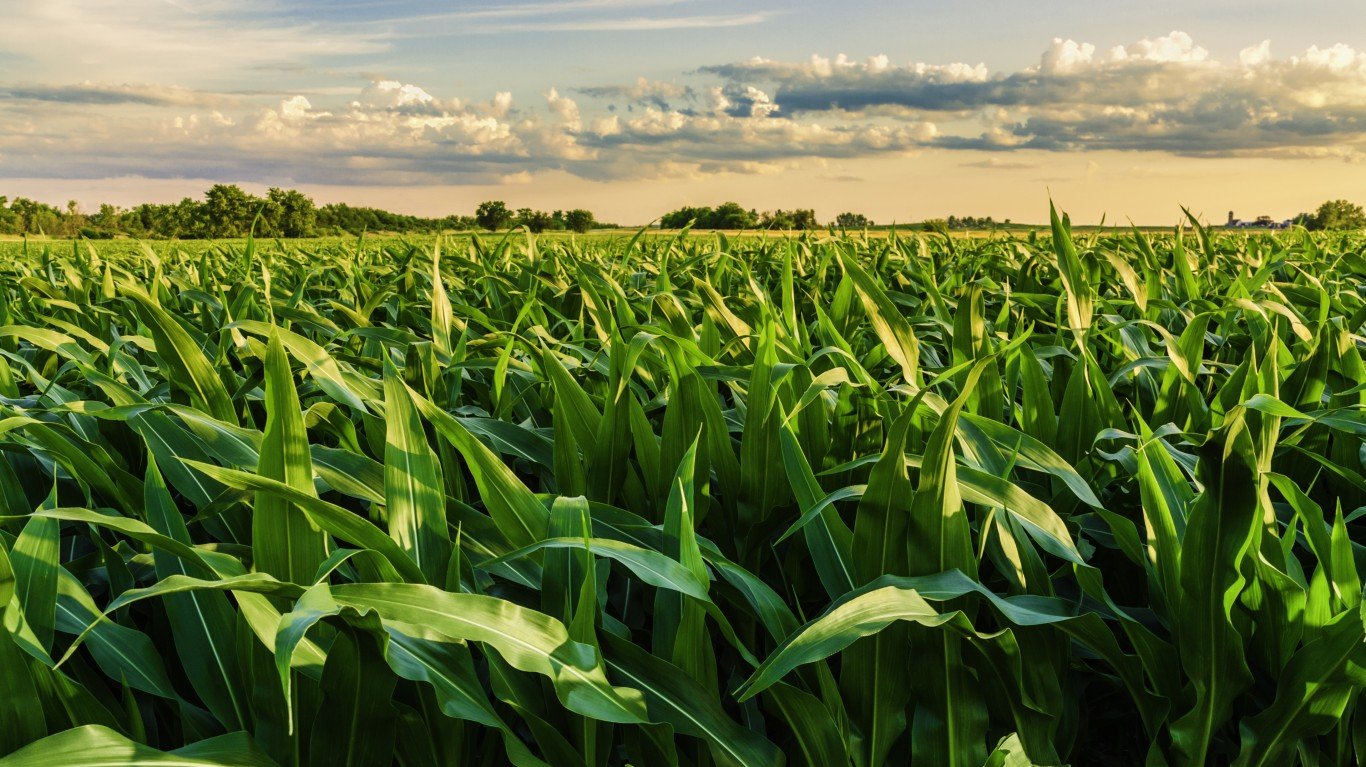
9. Illinois
> Pre-COVID avg. weekly unemployment benefit payout: $357 (25th lowest)
> Unemployment claims, mid-March through July 11: 1.4 million (21.7% of labor force — 11th lowest)
> Employment change, June 2019 to June 2020: -9.8% (18th largest decline)
> June 2020 unemployment rate: 14.6% (7th highest)
Illinois reported one of the highest unemployment rates in the country for June 2020, at 14.6%. The nationwide unemployment rate was 11.1%. It is one of only eight states in which unemployment increased more than 10% from June 2019 to June 2020.
Further, Illinois’ average weekly unemployment benefit — $357 — is lower than most states. Yet the state’s average weekly wage of $1,080 is among the highest in the nation. This makes Illinois one of just 10 states in which the average weekly unemployment benefit amount covers less than a third of the average weekly wage.

8. Delaware
> Pre-COVID avg. weekly unemployment benefit payout: $285 (12th lowest)
> Unemployment claims, mid-March through July 11: 120,592 (24.9% of labor force — 25th lowest)
> Employment change, June 2019 to June 2020: -10.5% (12th largest decline)
> June 2020 unemployment rate: 12.5% (10th highest)
Delaware ranks among the worst states to be unemployed in part because of its top 10 unemployment rate, at 12.5%. The state’s employment rate fell 10.5%, well above the overall U.S. decline of 8.6%.
In spite of the job losses, however, Delaware residents have been better able to meet their financial obligations than those in almost every other state, and they generally feel confident about their financial future. Just 14.3% of Delaware adults either missed their most recent mortgage payment, or are not confident they will make their next one, compared to 25.3% of Americans overall. Less than a quarter of Delaware adults live in a household that expects to lose employment income in the next four weeks, well below the U.S. rate of 34.9%.

7. Florida
> Pre-COVID avg. weekly unemployment benefit payout: $252 (6th lowest)
> Unemployment claims, mid-March through July 11: 3.2 million (30.9% of labor force — 15th highest)
> Employment change, June 2019 to June 2020: -6.1% (16th smallest decline)
> June 2020 unemployment rate: 10.4% (18th highest)
Before COVID-19 impacted the U.S. economy, only 8.9% of Florida’s unemployed residents were receiving benefits, a much smaller share than any other state. The nationwide share is 36.7%. Those Florida recipients got an average of $252 per week, well below the average U.S. weekly benefit.
Florida’s job market has not been as heavily affected by COVID as many other states’ economies. From June 2019 to June 2020, employment fell 6.1%, as compared to an 8.6% drop across America.
[in-text-ad-2]

6. California
> Pre-COVID avg. weekly unemployment benefit payout: $347 (22nd lowest)
> Unemployment claims, mid-March through July 11: 6.5 million (33.3% of labor force — 12th highest)
> Employment change, June 2019 to June 2020: -10.0% (15th largest decline)
> June 2020 unemployment rate: 14.9% (5th highest)
California has been one of the hardest-hit states by COVID-19, and it has also had one of the longest lockdowns, with stay-at-home orders first instituted on March 19. As of June, the state’s 14.9% unemployment rate was fifth highest among states, representing a 10 percentage point increase from a year prior. Across the state, 57.5% of adults are in households that have lost at least some employment income since mid-March, the fourth largest share of any state.

5. Michigan
> Pre-COVID avg. weekly unemployment benefit payout: $328 (17th lowest)
> Unemployment claims, mid-March through July 11: 1.7 million (34.6% of labor force — 11th highest)
> Employment change, June 2019 to June 2020: -12.8% (6th largest decline)
> June 2020 unemployment rate: 14.8% (6th highest)
Before the pandemic hit, Michigan already had one of the higher unemployment rates in the country, and things only got worse in 2020. Michigan had a 12.8% decline in employment in the last 12 months through June, the sixth largest decline of any state. As of June, the state’s 14.8% unemployment rate was also the sixth worst among states.
Across the state, 52.2% of adults are in households that have lost at least some employment income since mid-March, the eighth largest share of any state.
[in-text-ad]

4. Louisiana
> Pre-COVID avg. weekly unemployment benefit payout: $219 (2nd lowest)
> Unemployment claims, mid-March through July 11: 827,508 (39.8% of labor force — 6th highest)
> Employment change, June 2019 to June 2020: -8.7% (23rd largest decline)
> June 2020 unemployment rate: 9.7% (23rd highest)
Not including the additional $600 qualified residents are making during the COVID-19 pandemic, the average weekly unemployment payout in Louisiana is $219, nearly the lowest of any state and enough to cover only 29.5% of the average weekly working wage. The state is home to some 827,000 people who have claimed unemployment benefits since mid-March, and many of them are likely struggling to afford basic necessities.
Across Louisiana, 35.1% of adults report not being able to pay their monthly rent or mortgage and 17.6% of adults are in households that have not had enough to eat in the last week — each the second largest shares among states.

3. Alaska
> Pre-COVID avg. weekly unemployment benefit payout: $261 (7th lowest)
> Unemployment claims, mid-March through July 11: 154,731 (44.8% of labor force — 3rd highest)
> Employment change, June 2019 to June 2020: -11.4% (8th largest decline)
> June 2020 unemployment rate: 12.4% (11th highest)
Alaska ranks as the third worst state to be unemployed because its unemployment insurance benefits replace a lower share of wages than any other state. Its $261 average weekly benefit accounts for just 28.2% of the state’s $925 average weekly wage.
Alaska’s labor force has been hit especially hard by COVID-19. Nearly 45% of workers filed for unemployment from mid-March to July 11, the third highest percentage among states. Alaska reported a 12.4% unemployment rate in June 2020, a higher rate than all but 10 other states.
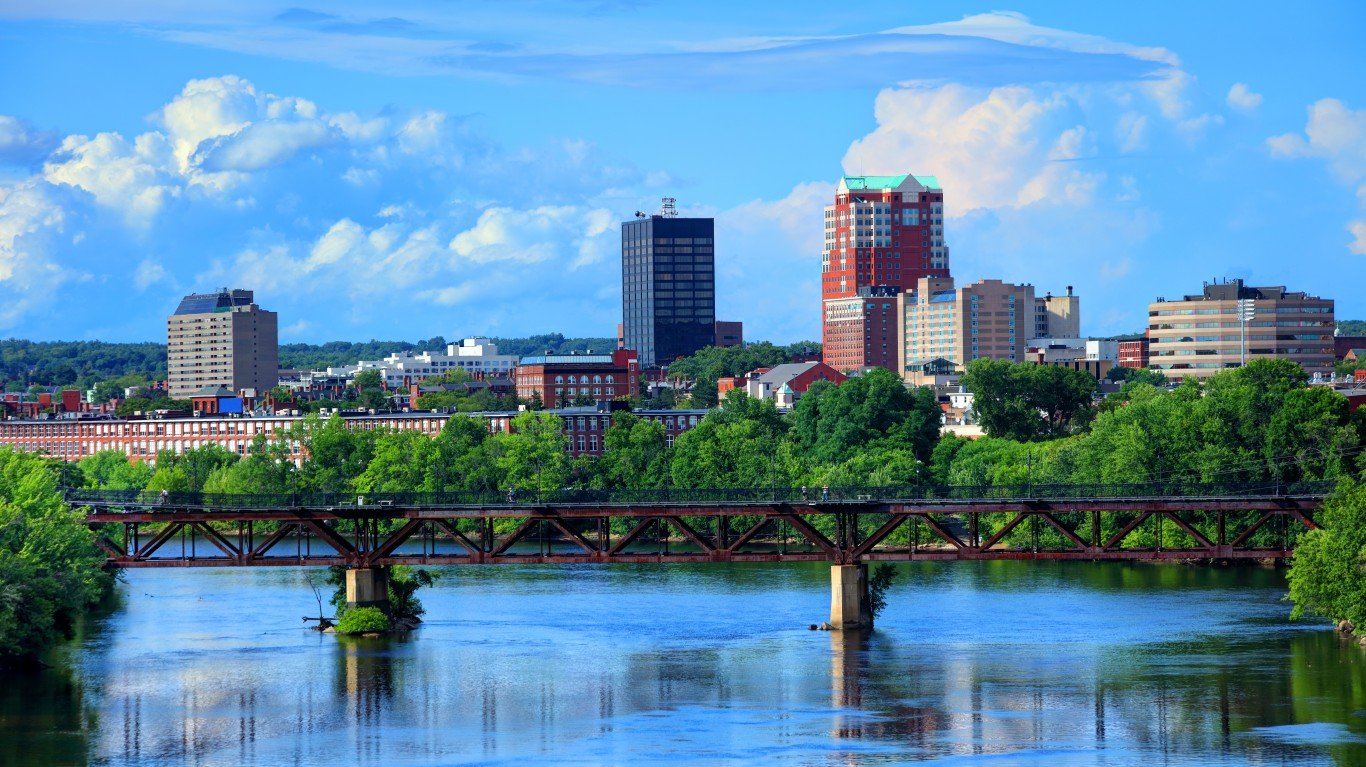
2. New Hampshire
> Pre-COVID avg. weekly unemployment benefit payout: $341 (19th lowest)
> Unemployment claims, mid-March through July 11: 236,886 (30.8% of labor force — 16th highest)
> Employment change, June 2019 to June 2020: -10.9% (9th largest decline)
> June 2020 unemployment rate: 11.8% (13th highest)
New Hampshire ranks second worst on this list due in large part to its low unemployment insurance benefits relative to wages. In the 12 months through the first quarter of 2020, the state’s average weekly benefits amounted to just 31.1% of the state’s average weekly wages, the fourth lowest replacement rate of any state. The effects of COVID-19 on the state economy may have had a particularly serious effect on consumer confidence: As of July 1, the state had the seventh-lowest Index of Consumer Sentiment score of any state.
[in-text-ad-2]

1. New York
> Pre-COVID avg. weekly unemployment benefit payout: $370 (19th highest)
> Unemployment claims, mid-March through July 11: 3.0 million (31.7% of labor force — 14th highest)
> Employment change, June 2019 to June 2020: -15.3% (2nd largest decline)
> June 2020 unemployment rate: 15.7% (3rd highest)
As one of the states initially hit hardest by the pandemic, New York’s job market remains badly affected. The state’s June unemployment rate of 15.7% is the third highest in the country. Across the state, more than half of adults are in households that have lost at least some employment income since mid-March, the third largest share of any state. Along with Alaska and New Jersey, New York is one of only three states to not temporarily waive the requirement that unemployment beneficiaries be actively searching for work.
The economic effects of COVID-19 and the resultant joblessness has had widespread effects on state residents. According to a recent survey conducted by the U.S. Census Bureau, nearly one third of adults in New York recently missed a monthly rent or mortgage payment, or would likely soon miss one — the sixth largest share of any state in the country.
Methodology
To identify the best and worst states to be unemployed, 24/7 Wall St. generated an index composed of four measures: the unemployment insurance (UI) recipiency rate, the UI replacement rate, the unemployment rate, and the one-year job growth rate. Data on the UI recipiency rate (the percentage of unemployed individuals receiving UI benefits) and the UI replacement rate (the average weekly UI benefit amount as a percentage of the average weekly wage) for the four quarters ending Q1 2020 came from the U.S. Department of Labor and were included in the index. Seasonally adjusted data on the unemployment rate as of June 2020 came from the U.S. Bureau of Labor Statistics and was included in the index. Seasonally adjusted data on total nonfarm employment also came from the BLS and was used to calculate change in employment from June 2019 to June 2020 and included in the index. Supplemental data on exhaustion rate and average benefits duration came from the DOL and are also for the four quarters ending Q1 2020.
Take This Retirement Quiz To Get Matched With A Financial Advisor (Sponsored)
Take the quiz below to get matched with a financial advisor today.
Each advisor has been vetted by SmartAsset and is held to a fiduciary standard to act in your best interests.
Here’s how it works:
1. Answer SmartAsset advisor match quiz
2. Review your pre-screened matches at your leisure. Check out the
advisors’ profiles.
3. Speak with advisors at no cost to you. Have an introductory call on the phone or introduction in person and choose whom to work with in the future
Take the retirement quiz right here.
Thank you for reading! Have some feedback for us?
Contact the 24/7 Wall St. editorial team.
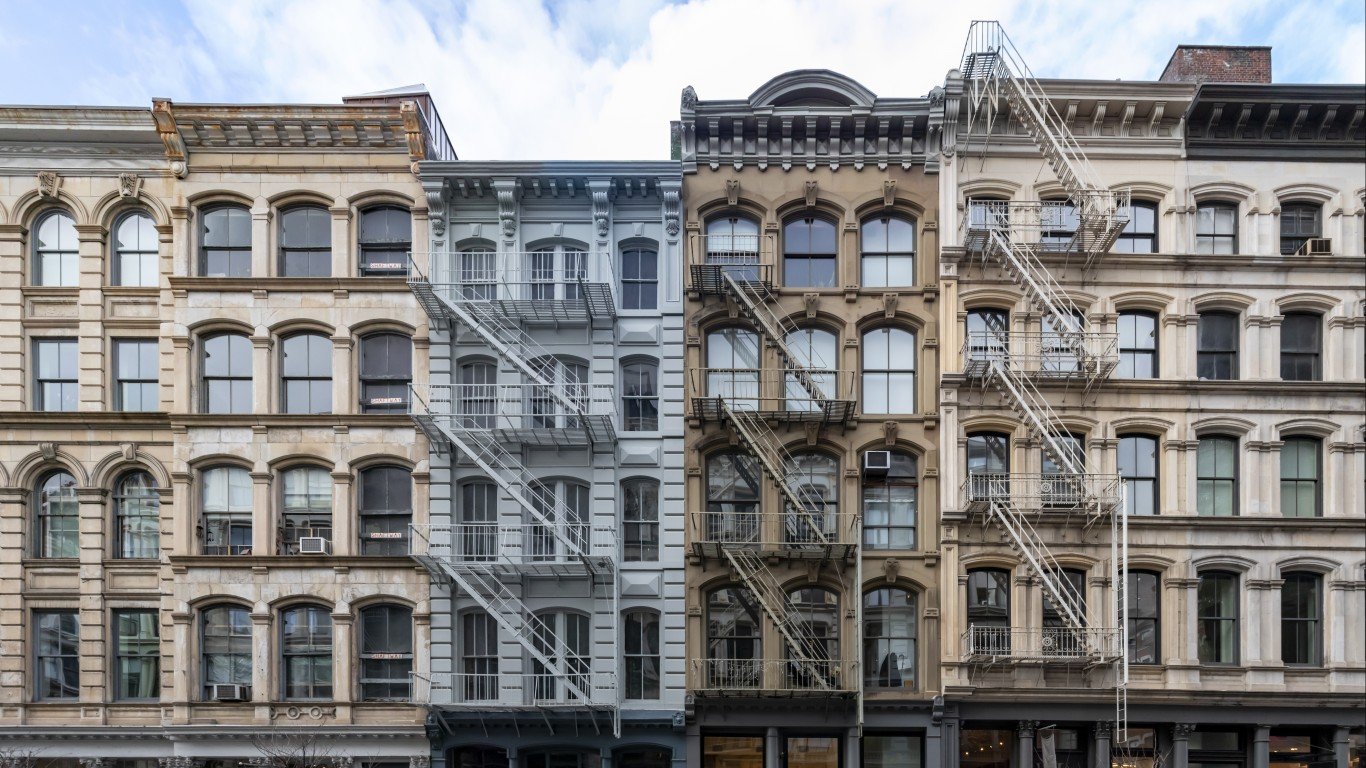 24/7 Wall St.
24/7 Wall St.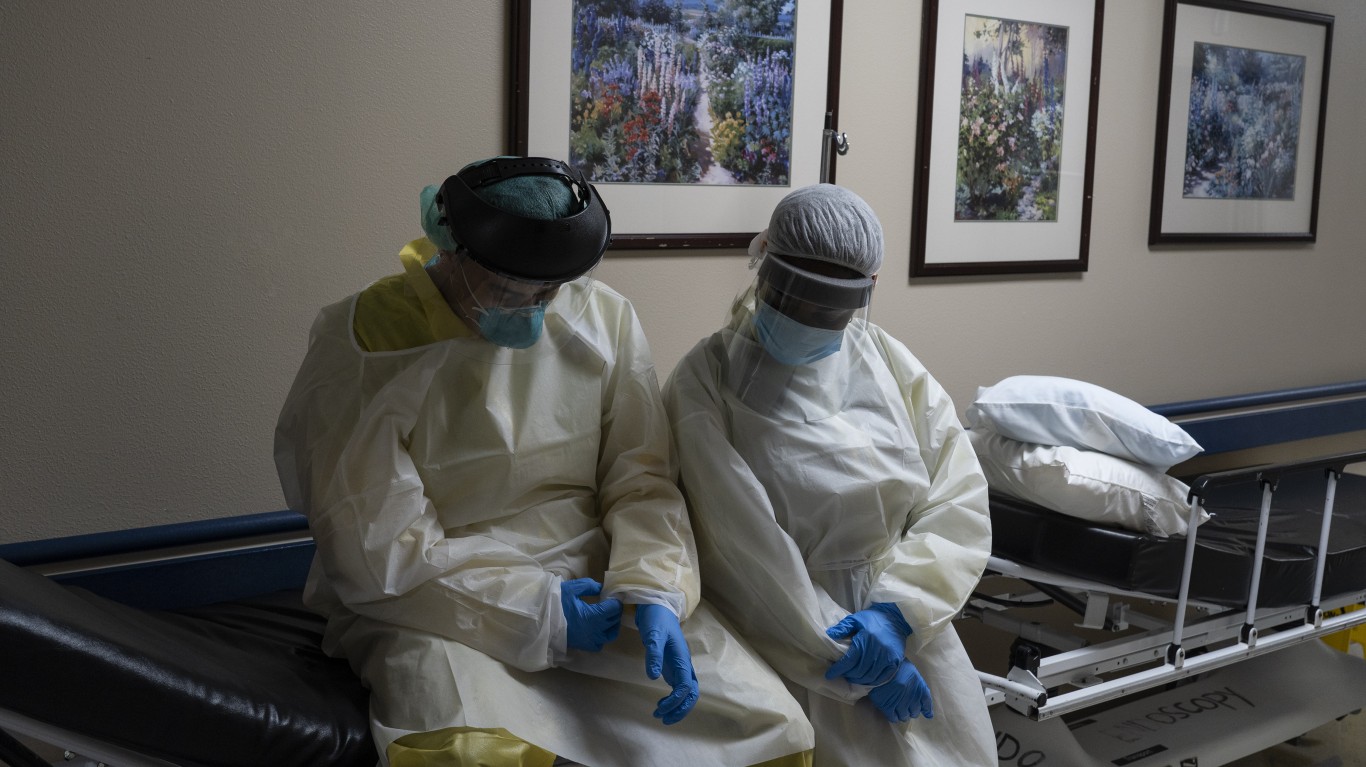 24/7 Wall St.
24/7 Wall St.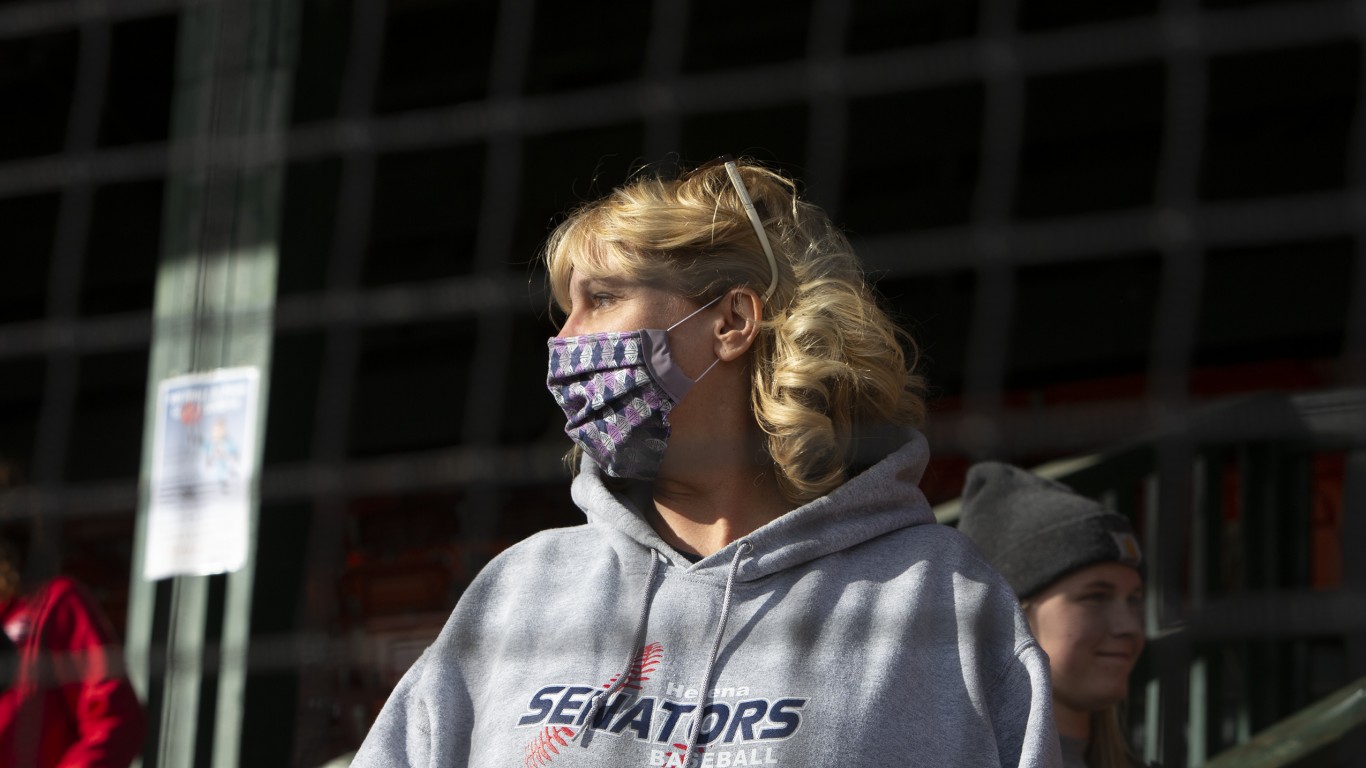 24/7 Wall St.
24/7 Wall St.


